Planning your RV trip is sometimes half the fun. Figuring out what things you want to do and deciding where to stay can help take your trip to the next level.
Yet you might not always be able to find exactly the power needs that perfectly fit your RV’s amp rating.
If RV campsites are in short supply, or you’re on the go looking for a place to stay on short notice, You might be wondering, “Can I plug my 30 amp RV Into a 50 amp shore power?
Yes, you can indeed safely plug your 30 amp RV into a 50 amp socket, you don’t have to worry about dealing with a long night without power. However, you do need to make sure that you have 120 volt 50 amp male plug on the male end and a 120 volt 30 amp female socket. You just take the 30 amp cord from your RV and plug it into the female socket on the adaptor. Once it’s seated snugly, you plug the male end of the adaptor into RV park’s 50 amp shore power socket.
How Does A 30 Amp Adapter Work?
These adapters typically come with a 120 Volt, 50 Amp male plug on one endwith a 120 Volt, 30 Amp female socket.
To use it you take the 30 Amp cord that runs from your RV or motorhome and then plug it into the female’s adapter socket.
You then plug the male end of the adaptor into the 50 Amp socket provided by the RV park.
If you do this in reverse order and the power is already active on the electrical post, you could risk blowing a fuse at some point in the system.
What Is The Difference Between A 50 Amp And A 30 Amp Outlet?
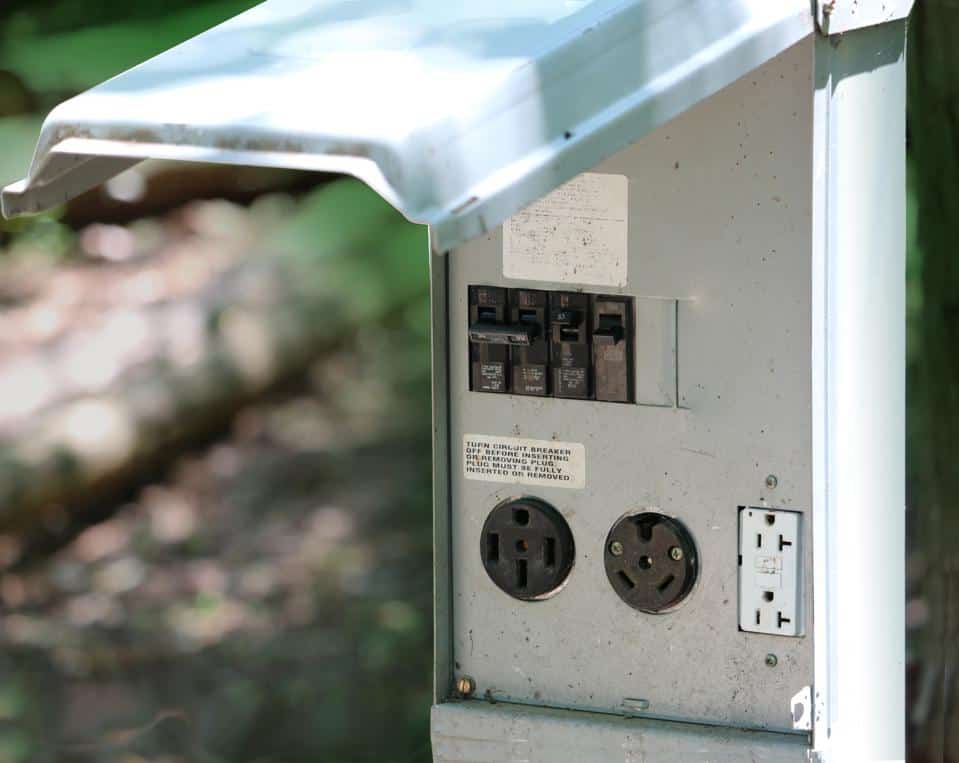
The main reason you can’t plug a 30 Amp into a 50 Amp, and vice versa is the starts with the physical differences between the two.
However, they also provide electricity in different ways.
A typical 30 amp plug features three prongs which include a 120 Volt“Hot Wire” which carries current, along with a neutral prong, and a ground wire.
Most RVs with low power requirements are set up fora 30 Amps system.
If you take a close look at a 50 Amp plug,you will see four prongs which include a pair of 120 Volt “Hot Wires” along with a neutral prong and a ground wire.
This configuration provides two separate 50 Amp 120 Volt electric lines to accommodate an RV with higher power needs.
In many cases, a 50 Amp system is necessary to handle the needs of running a large RV air conditioner and popular appliances, all at the same time.
Read Next: Difference Between A 30 Amp And A 50 Amp RV Electrical Outlet
Can I Plug My 30 Amp RV Into A 50 Amp Outlet?
The short answer here is that you can indeed access the power of a 30 Amp Outlet for an RV with a 50 Amp set up. However, you will again need a special adapter.
These adapters are a little harder to come by, but not impossible. You are more likely to find them in a large automotive store or electrical hardware section than you are to find them at a discount retail outlet.
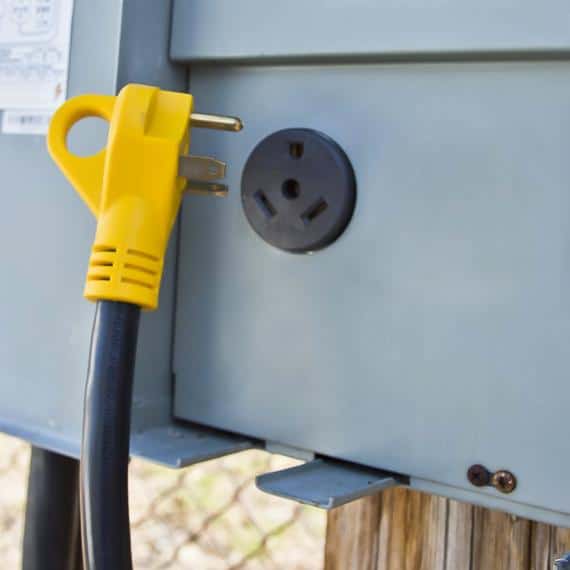
A quick internet search for the closest auto parts store will save you a lot of time beating the bushes for a 30 Amp to 50 Amp adapter.
If you are at the RV campground and they have one in the store for a couple of bucks more than at a distant auto parts store, it’s probably worth it to invest in one. You’ll end up saving yourself the money in fuel cost anyway.
Now, you shouldn’t just buy the adapter and expect everything to work perfectly. As before you will need to plug the adapter into the RV first before connecting to the live power post.
While the adapter will provide you with electricity it will only be at a maximum of 3,600 Watts.
When you consider that 50 Amp systems can typically handle up to 12,000 Watts, it could be a bit of a drawback.
This is one of those times to introduce your kids to the real-life lesson of conserving power.
At 3,600 Watts, you might be able to run your RV’s air conditioner on low, with some basic lights, and maybe the odd phone charger.
Where Can I Buy A 50 Amp Adapter Plug?
There are some well-established RV parks that are aware of just how common this problem is.
Many will have a cantina or a park store with basic items including 30 Amp to 50 Amp adaptors as well as 50 amp to 30 Amp adapters.
Yet just like a log of the things they sell, there’s usually a stiff markup on the cost.
If you don’t already have one of these adapters in your RV’s glove box, and you should, they are for sale in other stores. Most box retailer hardware stores have them available.
There are even a few discount stores that maintain a small selection of RV adapters in their automotive area.
Tips For Making The Most Of A 30 Amp Power Supply On A 50 Amp RV
As you might imagine, there are a few things you can do to minimize the inconvenience of the decreased level of available power.
1: Use One Air Conditioner Instead Of Two
Large motorhomes and fifth wheels often have two air conditioner systems. These tend to be the biggest power draw in the RV.
If at all possible, try to run only one of them to keep things comfortable.
2: Run The Generator
If you have a large RV or motorhome, then chances are it also has its own onboard generator that is rated to handle the standard power draw.
The system is technically set up to run while you are plugged into the shore power or an electric post.
However, many RV parks have rules about when you can run generators. Especially, loud two-stroke generators.
Some request that you stop running your generator after 9:00 pm. If their park covenants allow you to run up to a reasonable hour, you could use the time to pump your air conditioning up to the max, for a few hours before going to bed.
3: Run Your RV Fridge Off Propane
Most so-called “Two Way” RV refrigerators are what are known as “Absorption Refrigerators.” Instead of using compressed freon like the refrigerator in your kitchen, they use a blend of special fluids and gasses to replicate an evaporation effect.
This means you can technically run them off propane or electricity. Setting the RV fridge over to run on propane, will save you a little bit of electric power draw from the weaker system.
4: Cut Back On Appliances That Draw A Lot Of Power
Hairdryers, clothes driers, and other appliances that need a Ground Fault Circuit Interrupter (GFCI) draw a lot of power.
This means they could start to compete for power with the air conditioner and other onboard appliances.
5: Use The RV Park’s Shower Facilities
If your RV has a shower, then it also likely means that it has a water heater.
If you have multiple people who need to take a shower, or there is someone who likes to take long showers, it might be a good idea to use the RV park’s shower facilities.
This will spare your water heater competing with the air conditioner for power. It will also reduce the amount of humidity produced by the shower, which the AC will have to deal with.
Which One Is Better A 30 Amp Or A 50 Amp RV?
The answer to this question varies depending on how just how much shore power you intend to use when you are plugged in at the RV Park.
This will require taking out a pen and paper to do a little math. Calculating the necessary wattage and converting it to Amp requirements means multiplying by the voltage.
For example:
- A 20 Amp system x 120 Volts = 2,400 Watts
- A 30 Amp system x 120 Volts = 3,600 Watts
- A 50 Amp system X 120 Volts = 6,000 Watts
In the case of a 50 Amp shore power outlet, you have a pair of 50 Amp conductors, which means you essentially have access to 12,000 Watts available to use.
Taken in this context it’s a bit of a misnomer and should really be called a 100 Amp plug.
How Do I Know How Much Power My RV Needs?
Using your 30 Amp or 50 Amp power system as a guideline, you can start dialing in your wattage needs for each RV appliance, as well as the air conditioner.
You can start to build a picture of how many Watts you’ll need by checking each appliance.
Most have their power consumption information stamped into the bottom or on a small printed metal plate on the back.
Write them up on a list and then try to get a picture of how and when you will be using them. When adding them all up you want the wattage total to be below 80% of the system’s load capacity.
Your RV’s electric breaker box is set up to handle 80% load capacity. Anytime you go over that number, you risk tripping a circuit breaker, or blowing a fuse.
What’s The Average Wattage Range For Common RV Appliances?
Some RV appliance manufacturers are lax about stamping or printing energy information on the units they sell.
If you don’t happen to have the user manual at hand, you can use the following information to get an idea of the average wattage of some common RV appliances.
Some of these heat-producing appliances draw can draw nearly half of the available wattage for a 30 Amp RV system.
This means you will need to be thoughtful about when and how you use some of them with other appliances.
If your RV comes with Ground Fault Circuit Interrupters (GFCI) outlets, it’s a good idea to plug these high draw appliances into them.
Should the given appliance’s power draw exceed the allowed limit, the GFCI is more likely to trip, thus sparing you a trip to the breaker box.
What If I Want To Connect My 30 Amp RV To My Home?
Just because you aren’t on the road, doesn’t mean your RV has to go unused. If you have kids, who want to host a sleepover or company coming for a visit the RV might be a great place to set them up for the night.
It could also be a place where you can go for a moment’s peace, or read a good book.
In these scenarios, you will want to have electric power available in the RV, without having to necessarily run the generator.
Rather than play with this kind of power yourself, you should contact a licensed and bonded professional electrician.
For a very reasonable price, they can install a power post, pedestal, or other connection that allows you to run your RV off your home’s power.

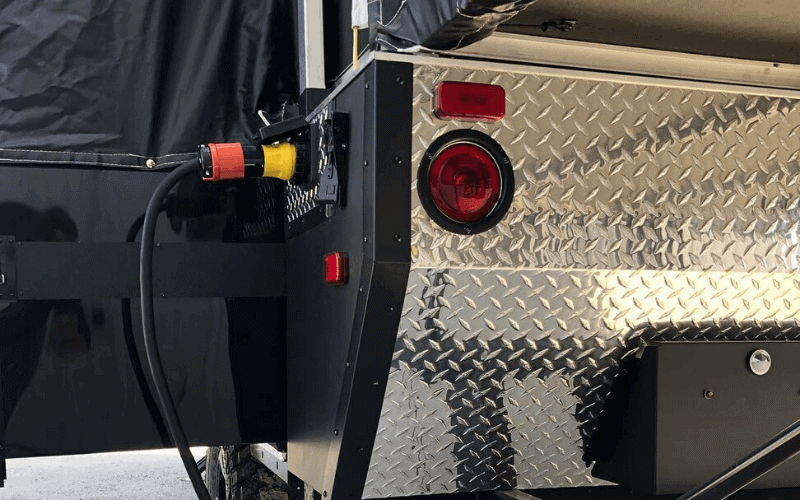

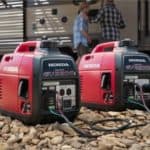
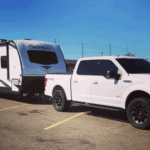
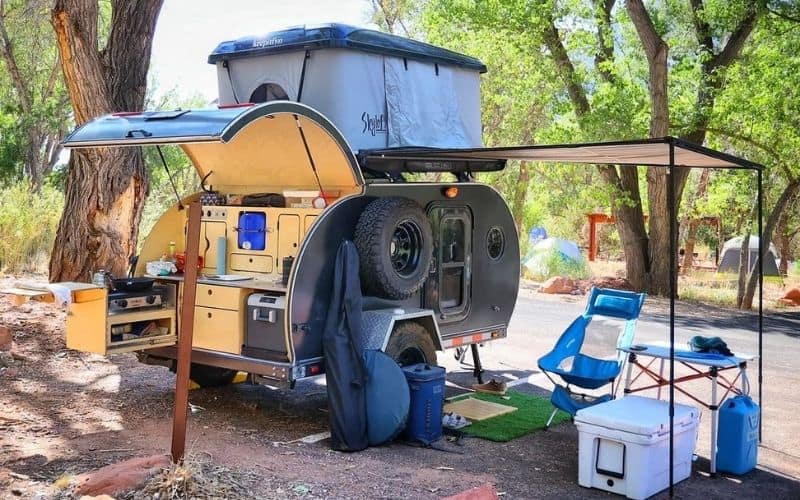
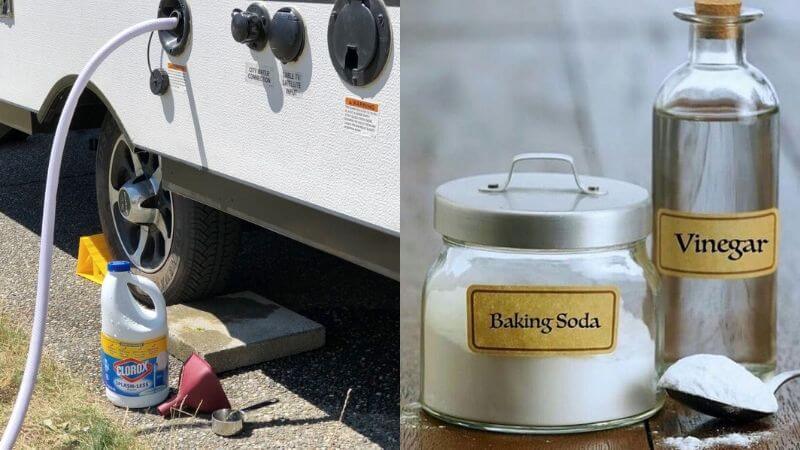
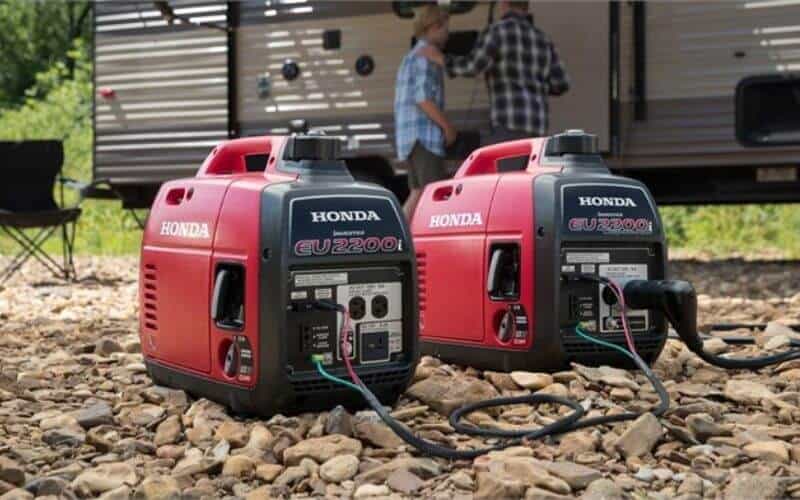
3 Comments
Kurt Belyeu
3 years agoUsing a cable rated for 30 amps will have conductors sized for 30 amps. The problem is you are using a dogbone to utilize a single leg of a 50 amp breaker which is a code violation due to the breaker being oversized for the conductors.
Stephen Willis
2 years agothe 30a breaker in your rv will protect your wiring
Rick Hoogkamp
1 year agoThe 30 amp breaker in rv protects the internal wiring but that does NOT protect undersized wiring from the pedestal plug through 30amp surge protector and thr rv cord into the rv distribution panel. I have seen numerous rv’s plugged into 50/60 amp double pole receptacles with 30 amp adapter that have burned up surge protectors and the 30 amp plug connectors. The last one melted connections in the junction box where the cable connects to fifth wheel internal wiring- almost starting rv on fire. This is on line side of 30 amp internal breaker which does nothing to protect that incoming wiring.
I have made an adapter box with a 50 amp male plug and 30 amp female plug that has an internal 30 amp breaker so that this eliminates this hazard- it is a ode violation to protect30 amp wiring with a larger 50/60 amp breaker. This practice could cost someone their RV or possibly their life and should be STOPPED,